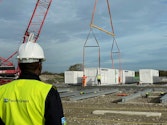Making project finance work for battery energy storage projects
- Establishing a workable template to underpin sector growth
- Lessons from one of Europe’s largest BESS project financings
Introduction
For all its promise of long-term cost savings, the energy transition carries a vast price tag. The Energy Transitions Commission estimated that achieving net-zero by 2050 would require an average annual investment of $3.5 trillion globally between 2021 and 2050. Consequently, sustaining progress toward a zero-emission society necessitates access to huge sums of capital and the full leverage of a wide range of funding mechanisms. Chief among them is project finance.
The importance of project finance for renewable energy projects cannot be overstated. Securing long-term finance for projects using a non-recourse financing mechanism has been pivotal to the successful scaling of the global wind and solar industries, especially in investment-grade countries.
As technology and development risks have been overcome, so the role of project finance in the roll-out of wind and solar projects has hit new heights. Quite simply, project finance has super-charged the deployment of renewables.
However, renewable energy assets will only fulfil their true potential if their deployment is accompanied by the build-out of sufficient amounts of energy storage facilities. As the World Bank puts it: “The global deployment of renewable energy is dependent on scaling up storage systems. It is the frontier that must be crossed to reach net zero and universal access to clean energy by 2030.” The International Renewable Agency (IRENA) has estimated that the world will need 360GW of battery storage by 2030 to enable us to get almost 70 per cent of our energy from renewable sources.
And yet, despite the overwhelmingly urgent need for energy storage around the world, the application of project finance mechanisms to battery energy storage projects has been patchy to date.
This report analyses the barriers to obtaining project finance for BESS projects, as well as highlighting the lessons that can be learnt from early BESS project finance success stories. It also explains:
- Why BESS asset owners are having to rethink their approach to revenue generation, which is a key concern for lenders
- Why lenders confidence in the BESS sector is increasing
- How to give lenders confidence in BESS project supply chains
- The template for successful BESS project financings
- How to develop an investor-friendly project management framework
- Why project optimisation is crucial
Why securing project finance for energy storage projects is challenging
It has traditionally been difficult to secure project finance for energy storage for two key reasons. Firstly, the nascent nature of energy storage technology means that fixed income lenders and senior debt providers are naturally risk averse. Battery storage has less of a track record than other renewable energy assets such as solar and wind power. The lack of comfort on the part of lenders has meant that the project financing packages available have been generally unappealing, with low gearing and onerous covenants.
The second, bigger obstacle to the project financing of storage assets is that the revenue stack for batteries is more complicated than for generating assets. Unlike wind and solar projects, battery projects are not generating electricity. Rather, they provide a service and act as arbitrage assets. With a battery storage asset, electricity is bought and sold at different times of day to make money by storing electricity when prices are low and discharging it when prices are high.
There are additional revenue streams that can be stacked – and lenders are becoming more comfortable with such a scenario – but none are as intuitive as renewable energy generation and there is generally less revenue certainty than there would be with solar or wind assets.
Why battery revenues are less certain than those for wind and solar
Lenders have been willing to lend to renewable assets against a guaranteed fixed revenue stream. This may take the form of a contract for difference, or some other sort of government-backed incentive, or a power purchase agreement with a bankable and creditworthy counterparty.
Indeed, in more recent times, some of those renewable energy technologies have become so well-established, with demonstrable risk management, that lenders are beginning to lend against merchant revenue streams, without the benefit of underwriting from a third-party offtake agreement.
In contrast, the battery storage sector is at an earlier stage in its development. With storage technology still very much in the research and development phase, funding battery projects is inevitably more complicated than funding renewables assets. Whereas solar panels have become commoditised, and, despite ongoing technological advances to improve efficiency or increase size, generally the underlying principle behind all wind assets is the same.

Emily Sidhu, director in the banking and investment team at UK Infrastructure Bank (UKIB), explains that the main barrier to the project financing of BESS projects relates to revenues. “There are different markets that batteries can sell into – capacity market, wholesale market, balancing mechanism and ancillary services – so there are different ways of making money, but it also means there is potentially higher revenue risk when compared to traditional renewable technologies that have contracts for difference, for example, and therefore more revenue certainty. So there’s a lot of volatility in the revenue and that’s why you’re seeing a more limited pool of commercial banks coming into the space.”
Lenders cautious due to lack of understanding of BESS projects
When it comes to batteries, product development involves the tweaking of a chemical reaction. This can involve quite complex concepts and since most bankers are not familiar with the intricacies of electrical engineering, and are reliant on expert advice when making decisions on financing BESS projects, they tend to be more risk averse. Anticipating the lender’s technical diligence and lines of enquiry both streamlines the process and also allows the developer to deal with any potential questions in advance. Pacific Green engaged a wide range of leading technical advisors who had worked with the banks before. By instructing its own advisors to view the project from the lenders’ perspective, Pacific Green was able to ensure it was as bankable as possible.
Another key consideration is predictability. While it is now commonplace to access incredibly detailed wind or solar irradiance forecasts, with a battery, the picture is more complicated. A BESS asset holder may be able to forecast the wholesale price, but that is not necessarily correlated with their ability to turn a profit. In order to be profitable, a battery asset’s performance must be optimised via machine-learning, which ensures a battery performs in accordance with the most effective operating schedule.
As Jacob Lloyd, managing director, structured finance at Natwest, explains, today’s storage sector is having to rethink its approach to revenue generation. He says: “Most batteries at the moment are being used in the arbitrage market, as well as for wholesale trading, dynamic containment and frequency response, but those have all been filled up – they were the big money makers two to three years ago, but we knew that wasn’t sustainable in the long-term.” Lloyd adds that the big question is now ensuring that batteries “are optimised well enough” in the Balancing Mechanism, the National Grid ESO’s primary tool for balancing supply and demand on Great Britain’s electricity network.

As batteries’ track record improves, lenders’ confidence grow
Generally speaking, a battery project has to be a certain size to make it attractive to project finance providers – historically a lot of energy storage projects have been quite small.
However, with early battery storage projects now able to point to a proven track record of successful operation, and with the scale of projects now coming through markedly larger, project finance providers are growing in confidence. Lloyd says there are more lenders in the BESS space than there were three or four years ago. “The liquidity and appetite will clearly increase, but there may not be more project financing of BESS projects, I think there could be fewer financings in total, but more large financings as the projects get bigger,” he explains. “Where you used to have 50MW or 100MW, you could be looking at 300MW or 500MW.”
Sidhu says one of UKIB’s objectives is to “try and bring other lenders into the BESS sector that might not be as confident in terms of the revenue risk by providing a kind of credit enhancement to other lenders”. UKIB has already enjoyed success in this respect as its co-financing – along with Natwest – of Pacific Green’s Sheaf Energy Park, a 249MW / 373 MWh energy storage park in Kent in the UK, demonstrates.
Sheaf Energy Park: Lessons on giving lenders confidence in supply chains
In 2023, Pacific Green reached financial close on Sheaf Energy Park, one of the first and largest non-recourse debt financed battery energy storage system (BESS) sites in the world.
Under the terms of the deal, a two-bank syndicate – consisting of NatWest and UK Infrastructure Bank (UKIB) each contributed £60 million (US$73 million) to a debt facility totalling £120 million (US$146 million). The facility will be used to fund the development and construction of Sheaf Energy Park, following which repayment will occur over a 10-year tenor upon the start of commercial operations.
The Sheaf deal follows in the footsteps of a number of earlier UK BESS project financings – including the provision of a £28.25 million debt facility for the Richborough Energy Park in Kent, another Pacific Green project at a site adjacent to the Sheaf Energy Park.
However, the Sheaf financing was notable because of its size. What also set it apart was its innovative approach to the construction of the project. Lloyd says that Pacific Green had a very good construction plan for Sheaf, which was “well contracted with well-established developers of assets”. As Pacific Green CEO Scott Poulter explains, the adoption of a “reverse engineering” approach was the key. “We began by asking ‘What is financeable? What’s going to get a tier one bank comfortable through full visibility, and confidence in the project returns?” Only then did we start to price up the project with our suppliers and counterparties. We turned the traditional approach on its head and in doing so could offer the investment community the certainty it needed on supply chain matters.”
Pacific Green’s supply chain strategy was key as this aspect is an important consideration for potential lenders. Lloyd says lenders will seek clarity on potential supply chain issues prior to the provision of project finance for BESS projects. He explains: “BESS projects are still nine months to two years in duration depending on how long it takes to secure your kit, which is normally transformers and batteries – batteries are often coming from China and if you consider recent incidents in the Red Sea, there is potential for supply chain disruption.”
A ‘template’ for future financings
Kate Shannon, principal associate at Gowling WLG, legal advisor to Pacific Green on the Sheaf development, suggests the deal could be used as a template for future BESS project financings. “Part of the process of lenders getting more comfortable with BESS financing is going to be the documents looking how they expect them to look,” she explains. “The Sheaf financing was more traditional [than previous BESS project financings] and there’s no reason why that couldn’t be used as a template.”
Nath Curtis, a partner at Gowling, adds that the fact that the Sheaf deal constituted a large, single asset financing represented a “positive signal to the market that you don’t necessarily have to have a big portfolio of diverse sites with the risk spread over various individual projects to be able to get financing”.
The structure of the Sheaf project financing was heavily influenced by that used for the financing of another earlier Pacific Green scheme, the 99MW Richborough Energy Park project. In each of these financings, Pacific Green combined best practice from the oil and gas sector - specifically expertise in developing large non-recourse project-financed infrastructure – to build a BESS project management framework that is replicable for other projects. Prior to this, other energy storage projects had each been approached as a unique initiative, with stakeholder engagement starting from scratch for each project. However, Pacific Green’s approach enabled more agile execution of projects.
Investor-friendly project management framework
The idea behind the agreements underpinning Richborough – of which there were 22 in total, with contracts totalling 5,000 pages – was that they could be used elsewhere across the UK and, with minor modifications, in overseas markets. The project management framework covered the entire lifespan of the scheme, from the land lease option and grid connection agreement to the power purchase deal and operations and maintenance.
The project management framework approach also ensured early engagement with stakeholders that is key to the on-time, on-budget delivery of BESS projects. Hallmarks of Pacific Green BESS project financings include using strong connections in Chinese industry to source batteries. This approach proved invaluable at a time when global lithium-ion supply chains were bought to a halt during the global COVID pandemic.
The project management framework initially developed for use at Richborough was designed to be investor-friendly, thereby allowing the scheme to be funded incrementally on a project finance basis. This was an approach believed to be unique in the UK energy storage market. The traditional approach to energy storage projects has restricted investment because it requires financiers to carry out significant due diligence whenever they fund a scheme – because of this, most energy storage investment has historically been off balance sheet or via specialist funds.
Project optimisation approach is crucial
The approach adopted at Richborough was replicated at Sheaf Energy Park and this proved instrumental in Pacific Green securing financing for the project as the company had prior experience of the challenges of developing a BESS asset. Sidhu says a combination of factors made Sheaf Energy project attractive to UKIB. “We liked the sponsor, we liked the fact that they'd done a project before and this was the second [project financing] so they had experience of doing a similar project previously.” She echoed the view that the Sheaf project could be used as a template for future financing.
Sidhu adds that UKIB also had a lot of confidence in the project optimiser’s ability to get the best out of the available revenue streams. Pacific Green entered into an agreement with SSE Energy Solutions for the provision of optimisation services over a ten-year period. SSE’s optimisation platform creates digital twins of projects that are utilised by machine learning to optimise the asset’s operating schedule. The location of the site, which is in the South of England, was also attractive to UKIB as it is close areas of high energy demand.
Conclusion
Securing project finance for BESS projects has been a thorny challenge for energy storage developers. However, with early examples of success now emerging, including at projects with genuine scale, the tide may be about to turn.
These projects have established a valuable template for other BESS project financings around the world. A key element of this template is a project management framework that is replicable for other projects, which is in contrast to the traditional approach to energy storage projects, which has had the effect of restricting investment because it requires financiers to carry out significant due diligence whenever they fund a scheme.
It is advised that the project management framework covers the entire lifespan of the scheme, incorporating the land lease option and grid connection agreement to the power purchase deal and operations and maintenance, for example. In addition, the framework should make provision for the early engagement with stakeholders that is key to the on-time, on-budget delivery of BESS projects. Project management frameworks should also be investor-friendly in order to facilitate the incremental funding of the project on a project finance basis.
In this way, more lenders can be enticed into providing project finance for BESS projects that will play a crucial role in speeding up the transition to a zero-emission society.








